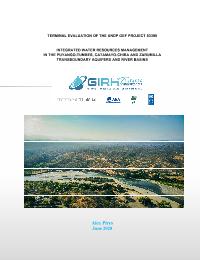
TERMINAL EVALUATION OF THE UNDP GEF PROJECT 83398 - INTEGRATED WATER RESOURCES MANAGEMENT IN THE PUYANGO-TUMBES, CATAMAYO-CHIRA AND ZARUMILLA TRANSBOUNDARY AQUIFERS AND RIVER BASINS
Output 1.2.2 Enabling environment strengthened to expand public and private financing for the achievement of the SDGs
Goal 12. Ensure sustainable consumption and production patterns
Goal 13. Take urgent action to combat climate change and its impacts
Goal 15. Protect, restore and promote sustainable use of terrestrial ecosystems, sustainably manage forests, combat desertification, and halt and reverse land degradation and halt biodiversity loss
12.4 By 2020, achieve the environmentally sound management of chemicals and all wastes throughout their life cycle, in accordance with agreed international frameworks, and significantly reduce their release to air, water and soil in order to minimize their adverse impacts on human health and the environment
13.2 Integrate climate change measures into national policies, strategies and planning
15.1 By 2020, ensure the conservation, restoration and sustainable use of terrestrial and inland freshwater ecosystems and their services, in particular forests, wetlands, mountains and drylands, in line with obligations under international agreements
1: Others


